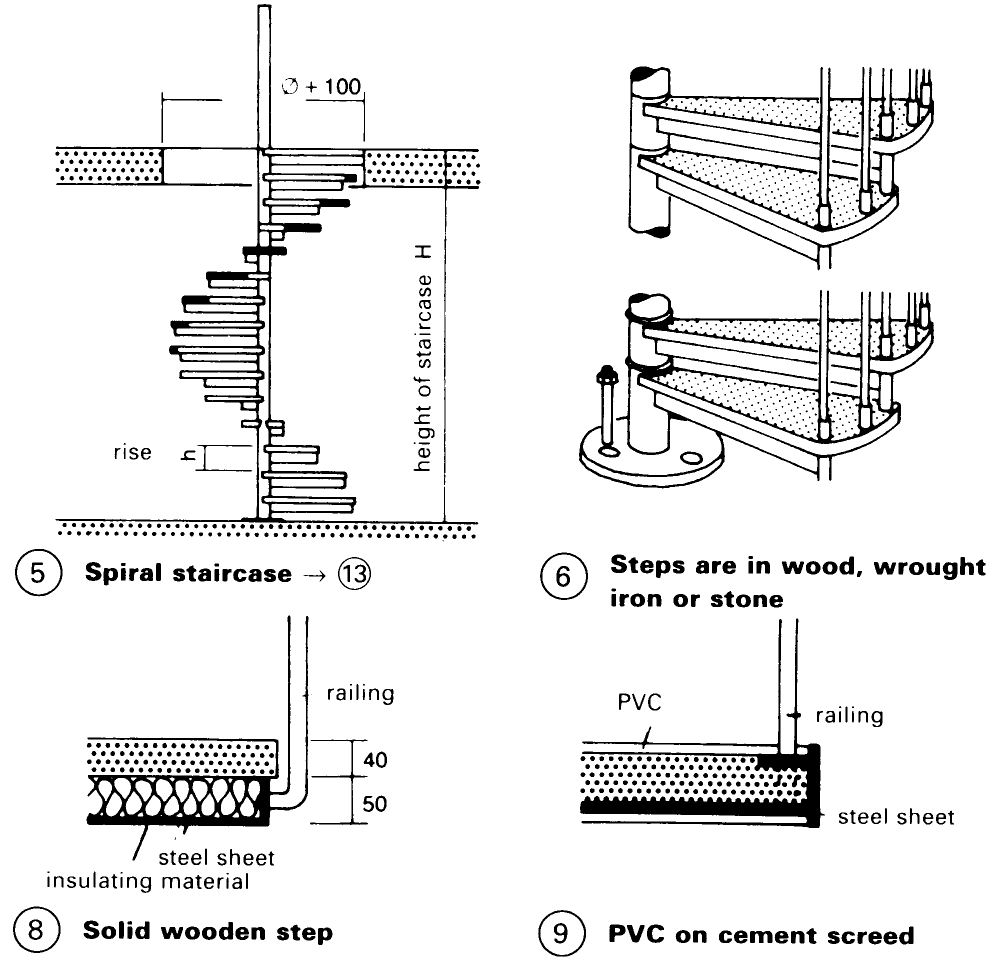Ramps and Spiral Staircases. Escalators
Ramps should be provided to allow wheelchair users and those with prams or trolleys to move easily from one level to another – (1) – (3).

Under building regulations, a main or 'essential' staircase with a ceiling aperture size of about 210cm diameter (with a minimum 80cm flight width) is permissible for family houses, and from 260cm for other buildings (with a minimum 1.00m flight width). Spiral stairs with less than 80cm effective flight width are only permitted as 'non-essential' stairs. Material used can be metal plate (with a plastic or carpet overlay if needed), marble, wood, concrete or stone – (6) - (9).

Stairs in prefabricated steel sections, aluminium castings or wood for installation on site, are suitable as service stairs, emergency stairs and stairs between floors – (13). Stair railings can be fitted in steel, wood or Plexiglas – (14).


Spiral staircases are space-saving and, with a pillar in their central axis, are of sturdy design – (5) – (6). They can, however, also be designed without a central pillar, giving an open winding staircase with a stairwell – (14) – (15).

Escalators. These guidelines are based on recommendations issued by the German Federations of Trade Associations. In the UK, reference is usually made to BS EN 115: 1995: Safety rules for the construction and installation of escalators and passenger conveyors.
Escalators – (1) – (3) are required to provide continuous mass transport of people. (They are not designated as 'stairs' in the provision of emergency escape.) Escalators, for example, in department stores rise at an angle of between 30° and 35°. The 35° escalator is more economical, as it takes up less surface area if viewed in plan but for large ascents, the 30° escalator is preferred both on psychological as well as safety grounds. The transportation capacity is about the same with both.


Escalators in public transport installations are subject to stringent safety requirements (for function, design and safety) and should have angles of ascent of 27-28°. The angle of rise is the ratio 3/16, which is that of a gentle staircase.
In accordance with a worldwide standard, the width of the step to be used is 60cm (for one-person width), 80cm (for one- to two-people width) and 100cm (for two-people width) – (7) - (9). A 100cm step width provides ample space for people carrying loads.

A flat section with a depth of >2.50m (minimum of two horizontal goings) should be provided at the access and exit points of the escalator.
In department stores, office and administration buildings, exhibition halls and airports the speed of travel should, as a rule, be no greater than 0.5m/s, with a minimum of three horizontal exit goings. For underground stations and public transport facilities, 0.65m/s is preferred.
The average split of traffic that goes upstairs in a large department store is:
- fixed stairs 2%
- lifts 8%
- escalators 90%
Coming down, about three-quarters of the traffic uses the escalators. According to current assessments, on average one escalator is installed for every 1500 m2 of sales area; but this average should be reduced to an optimum of 500-700m2.
Date added: 2023-01-01; views: 627;
